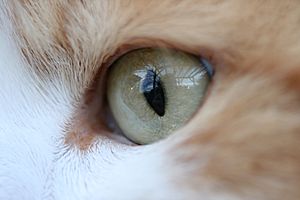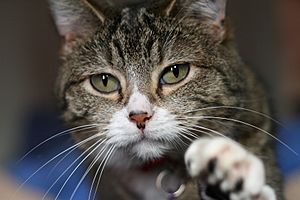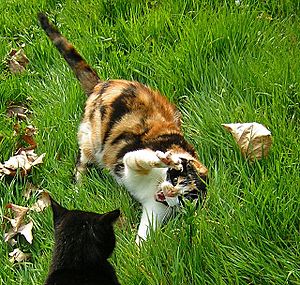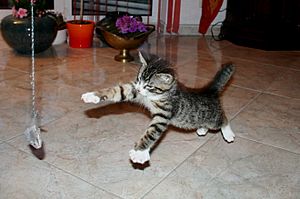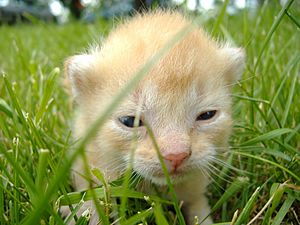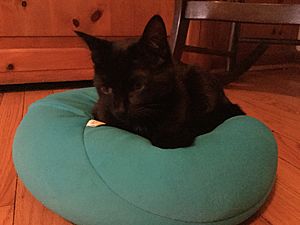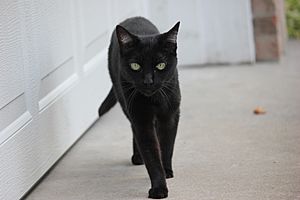Cat facts for kids
Quick facts for kids CatTemporal range: Pleistocene – Recent
|
|
|---|---|
 |
|
| Conservation status | |
| Scientific classification | |
| Kingdom: | |
| Phylum: | |
| Class: | |
| Order: | |
| Family: | |
| Genus: | |
| Binomial name | |
| Felis catus (Linnaeus, 1758)
|
|
Cats, also known as domestic cats (Felis catus), are small, meat-eating mammals. They belong to the family called Felidae. Many people keep domestic cats as pets in their homes. These are often called house cats.
Cats have been tamed by humans for almost 10,000 years. Some domestic cats live on farms to help catch rodents. These are called farm cats. Cats that live away from humans are called Feral cats. Cats are one of the most popular pets in the world. People keep them for hunting rodents and for companionship. There are about 60 different breeds of domestic cats. Some have short hair, some have long hair, and some have no hair at all! Cats that are not specific breeds are often called 'domestic shorthair' (DSH) or 'domestic longhair' (DLH).
A baby cat is called a kitten. People sometimes call cats kitty or pussycat. A female cat that can have kittens is called a queen. A male cat that can father kittens is called a tom.
The word cat can also mean other felines. Felines are usually known as either big cats or small cats. The big, wild cats are famous: lions, tigers, leopards, jaguars, pumas, and cheetahs. There are also small, wild cats in most parts of the world. Examples include the lynx in northern Europe and the bobcat in North America. Wild cats, no matter their size, are not tame and can be very dangerous.
Contents
Cat History
Long ago, especially in Egypt, people kept domestic cats. They were useful because they hunted and ate mice and rats. The oldest proof of cats kept as pets comes from the Mediterranean island of Cyprus. This was around 7500 BC.
Ancient Egyptians even thought cats were gods. They often mummified them. This was so the cats could be with their owners "forever."
Cat Body Parts
Cats have a body structure similar to other members of the Felis group. Their lower back and chest bones are extra flexible. This is why a cat's spine can bend so much. Unlike human arms, a cat's front legs are connected to the shoulder by bones that float freely. This lets cats squeeze their bodies through any space their head can fit through.
A cat's skull is special among mammals. It has large eye sockets and a strong, unique jaw.
Compared to other felines, domestic cats have canine teeth that are close together. This helps them eat their small rodents prey.
Cats have amazing night vision. They can see things very well in low light, much better than humans. This is partly because their eyes have a special layer called a tapetum lucidum. This layer reflects light back into the eye. It makes their eyes more sensitive to dim light. Cats also have a great sense of smell and very sharp hearing.
To help them move around and feel things, cats have many movable whiskers. These are called vibrissae. They are mostly on their faces. These whiskers tell the cat about the spaces they travel through. They also help them find objects in the dark. Whiskers can sense air currents and anything they touch. Whiskers also make cats blink. This protects their eyes from harm, just like human eyelashes do.
Cats walk very carefully. Unlike most mammals, cats use a "pacing" walk. They move the two legs on one side of their body first. Then they move the legs on the other side. When a cat walks faster into a trot, its walking style changes. It becomes a "diagonal" walk, like most other mammals. This means the front leg on one side and the back leg on the opposite side move at the same time. Cats, like dogs, walk directly on their toes. The bones of their feet make up the lower part of their leg.
Most cats have five claws on their front paws. They have four claws on their back paws. Their claws can be extended or pulled back in. When a cat is relaxed, its claws are hidden by the skin and fur around its paw pads. Cats can extend their claws for hunting, self-defense, climbing, kneading, or for better grip on soft ground.
On the inside of their front paws, there is something that looks like a sixth "finger." This special part on the inside of the wrist is called the carpal pad. Other cats and dogs also have this carpal pad.
Cat Behavior
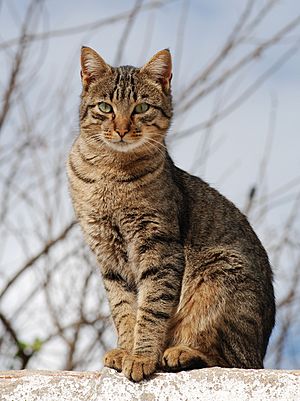
Cats are active carnivores. This means that in the wild, they hunt live prey. Cats are super fast, but only for short distances. Their main prey is small mammals, like mice. They will also sneak up on, and sometimes catch and eat, birds. Cats eat many different kinds of prey. This includes insects like flies and grasshoppers. Their main way of hunting is to stalk and pounce. The basic cat fur color, tabby (like the cat in the top photo), helps them hide well in grass and woodland. This is a kind of camouflage. The cat creeps towards its chosen victim. It keeps its body low to the ground so it's hard to see. It waits until it's close enough for a quick dash or pounce. Cats, especially kittens, practice these natural behaviors when they play with each other or with small toys.
Cats can even fish! They use a quick flip of a front paw. If they are successful, they flip the fish out of the water. It lands over the cat's shoulders onto the grass. Research from the Netherlands showed this is a natural behavior. Cats do it without being taught.
Cats are quiet and well-behaved animals. This makes them popular pets. Young kittens love to play. They can easily entertain themselves with toys from a store or made at home. House cats have even learned to open lever-style doorknobs and use toilet handles. You can train cats, but there's a limit. They can be as smart as dogs, but they don't live in packs.
Cats are quite independent animals. They can take care of themselves. They don't need or want as much attention as dogs do.
Kittens play all the time. This is how they learn. They will play their favorite games, like 'hide and pounce,' with almost anyone or anything. Soft balls on strings are a common toy. A scratching post is also very popular.
How Cats Communicate
Cats use many different sounds to talk. These include meowing, purring, trilling, hissing, growling, squeaking, chirping, clicking, and grunting.
Their body posture also helps them communicate. The way a cat holds its ears and tail tells other cats what it wants to say. The whole shape of its body changes when a cat is relaxed compared to when it is alert.
These ways of communicating are very important. They are used between a mother cat and her kittens. They are also used between male and female cats. And they are used between cats and other animals, like dogs. A mother cat protecting her kittens will fight even the biggest dog. She gives a good warning with a scary show. She hisses loudly, shows her claws, arches her back, and makes her fur stand on end. If that doesn't work, she attacks the dog's face with her claws. People say that no dog ever tries to attack a second time.
Cat Babies
The gestation period for cats is about two months. It usually lasts about 66 days. A litter (group of kittens born at once) usually has three to five kittens. Kittens start to eat solid food (are weaned) when they are about six to seven weeks old. Cats usually become old enough to have babies at 5–10 months for females and 5–7 months for males. Female cats can have two to three litters each year. They can have babies for about 10 years. This means a female cat could have up to 150 kittens in her lifetime!
Pregnant female cats give birth to their babies by themselves. They are guided by their natural instinct. They find the safest place they can. Then they clean it very well with their tongues if needed. Here, they will quietly give birth.
Kittens born in a home should not go outside until they are two to three months old.
How Cats Stay Clean
Cats are super clean animals. They clean themselves by licking their fur. A cat's tongue works like a hairbrush. It can clean and untangle a cat's fur. Still, owners might buy grooming tools to help their cat stay clean. After licking their fur, cats sometimes get hairballs. A hairball is a small clump of fur that animals vomit up when it gets too big. This is quite normal. Owners brush their cats to try and prevent as many hairballs as possible.
What Cats Eat
Today, special food for cats is easy to find in many countries. Many house cats eat food that their owners give them. This food is made to have the right nutrients for cats. Feeding a cat properly can help it live longer. This is better than if it hunted its own food or ate table scraps. Not feeding a cat correctly can cause health problems.
There are many different kinds of cat food. Most food comes as either wet food in a can or dry food in a bag or box. There are special foods for kittens, adult cats, and cats with health needs. There are even foods to help cats lose weight. These foods can be organic (made from natural ingredients). They can have vegetables, salmon, tuna, meat, and milk products. Since meat is the main part of a cat's diet, it's best to feed a cat food that is at least 95% meat. A cat should never eat only dog food every day. It could make the cat blind. Dog food does not have enough taurine, which is a nutrient important for a cat's eyes.
Cat Health
Cats can get sick, and it's always better to prevent diseases than to cure them. It's very important to get a young cat vaccinated. This protects them from some very serious diseases. If a cat does get sick, a veterinarian (an animal doctor) can help. Some cats might get sick more easily. This depends on their breed, gender, age, and overall health. Regular visits to the vet can find sickness early. This can help your cat live many extra years.
Cats that go outside will probably get fleas at some point. Cat fleas won't live on people, but they will bite anyone nearby. Owners can buy flea collars. Also, any areas where the cat usually sleeps need to be cleaned. A vet or local pet shop can give advice about preventing fleas (like a pill or chew the cat can eat) and treating them. It's a good idea to act fast when a cat gets fleas because fleas can make cats very uncomfortable.
House cats can become overweight. This happens if they don't get enough exercise and eat too much.
It's a good idea to adopt a cat from a vet or an animal shelter. The vet, shelter, or a local humane society will make sure the cat is healthy. They will also make sure the cat is spayed (surgically made unable to have babies).
How Long Cats Live
The average life of pet cats has gotten longer in recent years. In the early 1980s, cats lived about seven years. By 1995, it was 9.4 years. Now, in 2014 and 2023, it's about 13 years on average. Some cats have been reported to live into their 30s! The oldest known cat lived to be 38 years old.
Cat Superstitions
Many cultures have old beliefs about cats that are not true. For example, some people believe that a black cat crossing your path brings bad luck. Others thought cats were companions to witches. They believed cats helped witches become more powerful.
There's a myth in many cultures that cats have multiple lives. In many countries, people believe they have nine lives. But in Italy, Germany, Greece, Brazil, and some Spanish-speaking places, they are said to have seven lives. In Arabic traditions, the number of lives is six.
Fun Facts About Cats
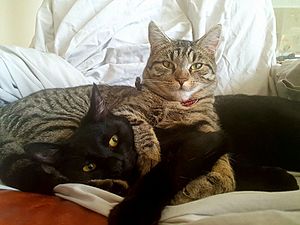
- Cats purr at a certain sound frequency. This frequency is between 25 and 150 Hertz. This is the same frequency that helps bones and muscles grow and repair themselves.
- Cats sweat through their paws. Since they are covered in fur, their paws are one of the few places they can sweat. Most of their sweat glands are on their paws.
- A cat's ears are controlled by more than 20 muscles.
- The nose ridge of a cat is as unique as human fingerprints.
- Cats can filter the salt out of seawater. This means they won't get dehydrated if they drink it, unlike humans.
- Cats (like dogs) eat grass to make themselves vomit. This helps them get rid of hairballs naturally.
- Cats can't taste anything sweet.
- A group of cats is called a clowder. A group of kittens is called a kindle.
- The love of cats is called Ailurophilia.
- "Barivel," a Maine Coon cat, is currently the longest domestic cat in the world (as of 2022). He measures 3 feet 11.2 inches (120 cm). He got this record in May of 2018.
Other Cat Pages
Images for kids
-
A cat eating a fish under a chair, a mural in an Egyptian tomb dating to the 15th century BC
-
Cat lying on rice straw
-
The hooked papillae on a cat's tongue act like a hairbrush to help clean and untangle fur.
-
A domestic cat with its prey, a deermouse
-
A tabby cat in snowy weather
-
Feral farm cat
See also
 In Spanish: Gato doméstico para niños
In Spanish: Gato doméstico para niños



